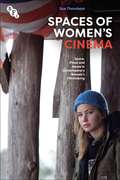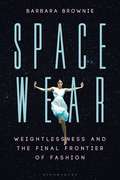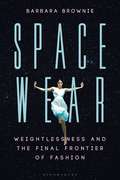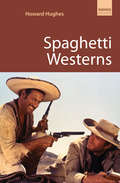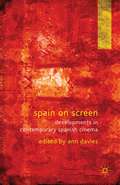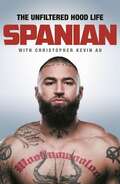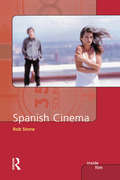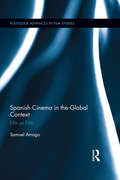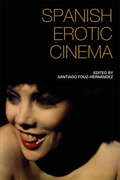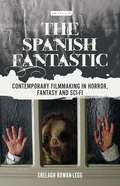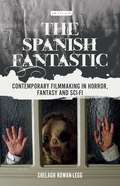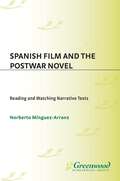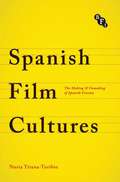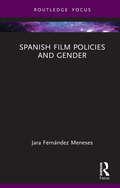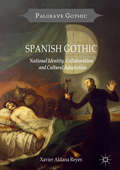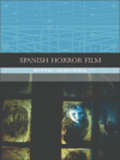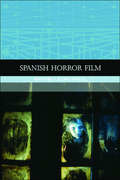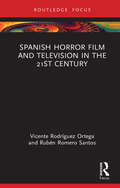- Table View
- List View
Spaces of Women's Cinema: Space, Place and Genre in Contemporary Women’s Filmmaking
by Sue ThornhamSue Thornham explores issues of space, place, time and gender in feminist filmmaking through an examination of a wide range of films by contemporary women filmmakers, ranging from the avant-garde to mainstream Hollywood. Beginning from questions about space itself and the way it has been gendered, she asks how representation functions in relation to space and time, and how this, too, is gendered, before moving to an exploration of how such questions might be considered in relation to women's filmmaking. In sections dealing with spaces from wilderness to city, she analyses in detail how these issues have been dealt with by women filmmakers, addressing the work of filmmakers such as Jane Campion, Kathryn Bigelow, Julie Dash, Maggie Greenwald, Patricia Rozema and Carol Morley, and films including 'An Angel at My Table' (1990), 'Daughters of the Dust' (1991) 'The Ballad of Little Jo' (1993), 'Winter's Bone' (2010), 'Zero Dark Thirty' (2012) and 'The Falling' (2014).
Spacewear: Weightlessness and the Final Frontier of Fashion
by Barbara BrownieToday, we are living in the New Space Age, where mass commercial space travel is almost within our grasp. This otherworldly possibility has opened up new cultural images of space, both real and fictional, and has caused fashion design and spacesuit engineering to intersect in new, exciting ways. Spacewear traverses this uncharted territory by exploring the changing imagination of space in fashion-and fashion in space-from the first Space Age to the 21st century. Exploring how space travel has stylistically and technologically framed fashion design on earth and how we need to revisit established design practices for the weightless environment, Spacewear connects the catwalk and the space station.This book draws together speculative fantasies in sci-fi films such as Star Trek and 2001: A Space Odyssey, with the engineered spacesuits Biosuit, and the NASA Z-2 and with catwalk interpretations by the likes of Alexander McQueen, Hussein Chalayan, André Courrèges, and Iris van Herpen. While the development of commercial space agencies has led to new concerns for style in garments for outer space that re-think fundamental design principles such as drape, high fashion has experimented with new possibilities for weightlessness that extend far beyond the 1960s vision of Space Age metallic fabrics and helmet-style headwear. Brownie takes the reader on a fascinating journey from fantasy to function and to form, deepening our understanding of this new category of fashion that is prompting new approaches to garment design and construction both on earth and in outer space.
Spacewear: Weightlessness and the Final Frontier of Fashion
by Barbara BrownieToday, we are living in the New Space Age, where mass commercial space travel is almost within our grasp. This otherworldly possibility has opened up new cultural images of space, both real and fictional, and has caused fashion design and spacesuit engineering to intersect in new, exciting ways. Spacewear traverses this uncharted territory by exploring the changing imagination of space in fashion-and fashion in space-from the first Space Age to the 21st century. Exploring how space travel has stylistically and technologically framed fashion design on earth and how we need to revisit established design practices for the weightless environment, Spacewear connects the catwalk and the space station.This book draws together speculative fantasies in sci-fi films such as Star Trek and 2001: A Space Odyssey, with the engineered spacesuits Biosuit, and the NASA Z-2 and with catwalk interpretations by the likes of Alexander McQueen, Hussein Chalayan, André Courrèges, and Iris van Herpen. While the development of commercial space agencies has led to new concerns for style in garments for outer space that re-think fundamental design principles such as drape, high fashion has experimented with new possibilities for weightlessness that extend far beyond the 1960s vision of Space Age metallic fabrics and helmet-style headwear. Brownie takes the reader on a fascinating journey from fantasy to function and to form, deepening our understanding of this new category of fashion that is prompting new approaches to garment design and construction both on earth and in outer space.
Spaghetti Westerns: The Filmgoers' Guide To Spaghetti Westerns (Pocket Essentials Ser.)
by Howard HughesOnce upon a time in the West, Clint Eastwood earned himself a fistful of dollars - and instant stardom- when his 'Man With No Name' rode into town. In the mid-sixties Eastwood's Dollars trilogy with director Sergio Leone - A Fistful of Dollars, For a Few Dollars More and The Good, the Bad and the Ugly - gunned down all opposition at the world box office and created a visceral new brand of anti-Western, dubbed 'Spaghetti Westerns' by critics bemused by the films' popularity. Spaghetti Westerns' cynical morality tales of revenge, betrayal and mercenary avarice were filmed in the desert badlands of Almeria, Southern Spain. Eastwood's immortal 'Man With No Name' is the enduring symbol of the genre, but Leone and Eastwood weren't the first, nor the most prolific filmmakers to make Spaghetti Westerns, and this Kamera Guide reviews the best of a wild bunch, including cult classics Django, The Big Gundown, They Call Me Trinity and Navajo Joe. Spaghetti Westerns examines the genre, from the most famous offerings- Once Upon a Time in the West and the Dollars trilogy- to offbeat fare, such as Cemetery Without Crosses and Django Kill. It charts the Spaghetti Western careers of Lee Van Cleef, Terence Hill and Klaus Kinski as they rode to international stardom, and appraises maestro Ennio Morricone's groundbreaking Western scores. In addition to an introduction to the genre, 34 of the best Spaghetti Westerns are analysed in detail, illustrated with rare colour posters and stills. There is also a multi- media reference section, listing essential books, websites, DVD releases and soundtracks.
Spain on Screen: Developments in Contemporary Spanish Cinema
by Ann DaviesA collection of original essays from leading scholars in the field exploring the contemporary debates, concerns and controversies ongoing in Spanish film industry, culture and scholarship. The essays reveal the far-reaching shifts that have occurred in the Spanish film scene, making essential reading for all interested in European cinema.
Spanian: The Unfiltered Hood Life
by SpanianBy the time he was twelve, Spanian knew he would follow his family's footsteps to become a career criminal. What followed was a decade-long string of brazen crimes and brutal violence: stabbings, ram-raids, drug runs and a notorious high school siege. Throughout the Sydney social housing enclaves of Redfern, Waterloo and Woolloomooloo, Spanian earned a reputation as one of the city's most flagrant crooks; armed with a boxcutter in one hand, and a syringe in the other.But it all came at a damning price: in the throes of heroin addiction and thirteen years wasted behind bars, Spanian became a longstanding resident of jails across New South Wales. There, he was embroiled in racial divisions, prison politics, and a vicious vortex of self-destruction, until music and books became an unlikely lifeline. Reading and rapping became new rituals, and a glistening light at the end of the tunnel. Released from Bathurst Correctional Centre in 2017 with newfound purpose, Spanian has since found viral fame and a sprawling, worldwide audience through hip-hop and his magnetic social media presence.This is the powerful, unflinching and high-octane memoir of how a young inner-city kid became Spanian. It gives unapologetic insight into the gritty socio-economic underbelly of Sydney city, the criminal justice system, and the correctional system. The story of Spanian provides hope that even the most stubborn cycles can be broken, and new dreams made.
Spanish Cinema
by Rob StoneFrom the surrealist films of Luis Buñuel to the colourful melodramas of Pedro Almodóvar, Spain has produced a wealth of exciting and distinctive film-makers who have consistently provided a condoning or dissenting eye on Spanish history and culture. For modern cinema-goers, it has often been the sexually-charged and colourful nature of many contemporary Spanish films, which has made them popular world-wide and led directors and stars such as Almodóvar, Banderas and Penélope Cruz to be welcomed by Hollywood. Using original interview material with Spanish Cinema luminaries such as Carlos Saura, Julio Medem, Imanol Uribe and Elías Querejeta, Rob Stone charts a history of Spanish Cinema throughout the turbulent Francoist years and beyond. The book aims to provide a broad introduction to Spanish Cinema, the nine chapters divided into four types: chapters on Spanish Cinema during the Dictatorship and following the transition to democracy survey current debate and opinion while tracing the development of themes and film movements throughout those periods. chapters on early Spanish cinema and Basque cinema present vital and fascinating aspects of Spanish cinema that have previously been ignored chapters on childhood in Spanish cinema, and sex and the new star system offer new pathways into the study of Spanish cinema chapters on Carlos Saura, Elías Querejeta and Julio Medem offer specific case studies of film-makers who are emblematic of different periods in Spanish cinema and, indeed, Spanish history As with other titles in the Inside Film series, the book is comprehensively illustrated with representative stills and has a thorough bibliography, index and list of resources.
Spanish Cinema
by Rob StoneFrom the surrealist films of Luis Buñuel to the colourful melodramas of Pedro Almodóvar, Spain has produced a wealth of exciting and distinctive film-makers who have consistently provided a condoning or dissenting eye on Spanish history and culture. For modern cinema-goers, it has often been the sexually-charged and colourful nature of many contemporary Spanish films, which has made them popular world-wide and led directors and stars such as Almodóvar, Banderas and Penélope Cruz to be welcomed by Hollywood. Using original interview material with Spanish Cinema luminaries such as Carlos Saura, Julio Medem, Imanol Uribe and Elías Querejeta, Rob Stone charts a history of Spanish Cinema throughout the turbulent Francoist years and beyond. The book aims to provide a broad introduction to Spanish Cinema, the nine chapters divided into four types: chapters on Spanish Cinema during the Dictatorship and following the transition to democracy survey current debate and opinion while tracing the development of themes and film movements throughout those periods. chapters on early Spanish cinema and Basque cinema present vital and fascinating aspects of Spanish cinema that have previously been ignored chapters on childhood in Spanish cinema, and sex and the new star system offer new pathways into the study of Spanish cinema chapters on Carlos Saura, Elías Querejeta and Julio Medem offer specific case studies of film-makers who are emblematic of different periods in Spanish cinema and, indeed, Spanish history As with other titles in the Inside Film series, the book is comprehensively illustrated with representative stills and has a thorough bibliography, index and list of resources.
Spanish cinema 1973–2010: Auteurism, politics, landscape and memory
by Maria M. Delgado Robin FiddianThis collection offers a new lens through which to examine Spain’s cinema production following the isolation imposed by the Franco regime. The seventeen key films analysed in the volume span a period of 35 years that have been crucial in the development of Spain, Spanish democracy and Spanish cinema. They encompass different genres (horror, thriller, melodrama, social realism, documentary), both popular (Los abrazos rotos/Broken Embraces, Vicky Cristina Barcelona) and more select art house fare (En la ciudad de Sylvia/In the City of Sylvia, El espíritu de la colmena/Spirit of the Beehive) and are made in English (as both first and second language), Basque, Castilian, Catalan and French. Offering an expanded understanding of ‘national’ cinemas, the volume explores key works by Guillermo del Toro and Lucrecia Martel alongside an examination of the ways in which established auteurs (Almodóvar, José Garci, Carlos Saura) and younger generations of filmmakers (Cesc Gay, Amenábar, Bollaín) have harnessed cinematic language towards a commentary on the nation-state. The result is a bold new study of the ways in which film has created new prisms that have determined how Spain is positioned in the global marketplace.
Spanish Cinema in the Global Context: Film on Film (Routledge Advances in Film Studies #26)
by Samuel AmagoAcross a broad spectrum of media, markets, and national contexts, self-reflexivity continues to be a favored narrative mode with wide ranging functions. In this book Amago argues that, in addition to making visible industry and production concerns within the film text, reflexive aesthetics have a cartographic function that serves to map the place of a film (geographic and cultural) within the global cinemascape, and thus to bring into sharper relief images of the national. Focusing on films in the contemporary Spanish context that in some way reflect back on themselves and the processes of their own production, that purposefully blur the distinction between reality and fiction, or that draw attention to the various modes of cinematic exhibition and reception, Amago proposes ways in which these movies can be employed to understand Spanish national cinemas today as imbedded within a dynamic global system.
Spanish Cinema in the Global Context: Film on Film (Routledge Advances in Film Studies)
by Samuel AmagoAcross a broad spectrum of media, markets, and national contexts, self-reflexivity continues to be a favored narrative mode with wide ranging functions. In this book Amago argues that, in addition to making visible industry and production concerns within the film text, reflexive aesthetics have a cartographic function that serves to map the place of a film (geographic and cultural) within the global cinemascape, and thus to bring into sharper relief images of the national. Focusing on films in the contemporary Spanish context that in some way reflect back on themselves and the processes of their own production, that purposefully blur the distinction between reality and fiction, or that draw attention to the various modes of cinematic exhibition and reception, Amago proposes ways in which these movies can be employed to understand Spanish national cinemas today as imbedded within a dynamic global system.
Spanish Cinema of the New Millennium (PDF)
by Thomas DevenySpanish Cinema of the New Millennium provides a new approach to the study of contemporary Spanish cinema between 2000 and 2015, by analysing films that represent both ‘high’ and ‘popular’ culture side by side
Spanish Erotic Cinema
by Santiago Fouz-HernandezThe first comprehensive scholarly study of Spanish erotic cinema, this book covers a significant part of the history of Spanish film, from the 1920s until the present day. Starting with a study of the kiss in silent films, the volume explores homoerotic narratives in the crusade films of the 1940s, the commodification of bodies in the late Franco period, and the so-called destape (literally ‘undressing’) period that followed the abolition of censorship during the democratic transition. Reclaiming the importance of Spanish erotic cinema as a genre in itself, a range of international scholars demonstrate how the explicit depiction of sex can be a useful tool to illuminate current and historic social issues including ageism, colonialism, domestic violence, immigration, nationalisms, or women and LGBT rights. Covering a wide range of cinematic genres, including comedy, horror and melodrama, this book provides an innovative and provocative overview of Spanish cinema history and society in the twentieth and twenty-first centuries.
Spanish Erotic Cinema
by Santiago Fouz-HernandezThe first comprehensive scholarly study of Spanish erotic cinema, this book covers a significant part of the history of Spanish film, from the 1920s until the present day. Starting with a study of the kiss in silent films, the volume explores homoerotic narratives in the crusade films of the 1940s, the commodification of bodies in the late Franco period, and the so-called destape (literally ‘undressing’) period that followed the abolition of censorship during the democratic transition. Reclaiming the importance of Spanish erotic cinema as a genre in itself, a range of international scholars demonstrate how the explicit depiction of sex can be a useful tool to illuminate current and historic social issues including ageism, colonialism, domestic violence, immigration, nationalisms, or women and LGBT rights. Covering a wide range of cinematic genres, including comedy, horror and melodrama, this book provides an innovative and provocative overview of Spanish cinema history and society in the twentieth and twenty-first centuries.
The Spanish Fantastic: Contemporary Filmmaking in Horror, Fantasy and Sci-fi (World Cinema)
by Shelagh Rowan-LeggIn recent decades, the Spanish 'fantastic' has been at the forefront of genre filmmaking. Films such as The Day of the Beast, the Rec trilogy, The Orphanage and Timecrimes have received widespread attention and popularity, arguably rescuing Spanish cinema from its semi-invisibility during the creativity-crushing Franco years. By turns daring, evocative, outrageous, and intense, this new cinema has given voice to a generation, both beholden to and yet breaking away from their historical and cultural roots.
The Spanish Fantastic: Contemporary Filmmaking in Horror, Fantasy and Sci-fi
by Shelagh Rowan-LeggIn recent decades, the Spanish 'fantastic' has been at the forefront of genre filmmaking. Films such as The Day of the Beast, the Rec trilogy, The Orphanage and Timecrimes have received widespread attention and popularity, arguably rescuing Spanish cinema from its semi-invisibility during the creativity-crushing Franco years. By turns daring, evocative, outrageous, and intense, this new cinema has given voice to a generation, both beholden to and yet breaking away from their historical and cultural roots. Beginning in the 1990s, films from directors such as Alex de la Iglesia, Alejandro Amenabar, and Jaume Balaguero reinvigorated Spanish cinema in the horror, science fiction and fantasy veins as their work proliferated and took centre stage at international festivals such as Sitges, Fantasia International Film Festival and Fantastic Fest. Through an examination of key films and filmmakers, Shelagh Rowan-Legg here investigates the rise of this unique new wave of genre films from Spain, and how they have recycled, reshaped and renewed the stunning visual tropes, wild narratives and imaginative other worlds inherent to an increasingly influential cinematic field.Its emergence is part of a new trend of postnational cinema, led by the fantastic, which approaches the national boundaries of cinema with an exciting sense of fluidity.
Spanish Film and the Postwar Novel: Reading and Watching Narrative Texts (Non-ser.)
by Norberto Mínguez-ArranzThe novel and the film are two modes of representation based on different aesthetic tools, but both are capable of articulating narrative discourses. In Spanish Film and the Postwar Novel, author Norberto Minguez-Arranz offers a comparative analysis of the methods and mechanisms with which the novel and the film build their stories. A theoretical framework that that puts into perspective such concepts as specificity, representation, and point of view gives way to a comparative study of five Spanish postwar novels and their respective film adaptations: The Family of Pascual Duarte, Time of Silence, The Hive, El Bosque Animado, and Nuevas Amistades.Revealing the existence of cinematic features of the novel and literary features of the cinema, the author examines the ways in which this interdependence has become a permanent aspect of both arts, with mutual influences and a great deal of nonexclusivity of properties. By using this particular time and place as his locus of analytical thought, Minguez-Arranz provides an invaluable examination of two of this century's major creative forms.
Spanish Film Cultures: The Making and Unmaking of Spanish Cinema (Cultural Histories of Cinema)
by Núria Triana-ToribioThe past four decades have seen the Spanish film industry rise from isolation in the 1970s to international recognition within European and World Cinema today. Exploring the cultural and political imperatives that governed this success, this book shows how Spanish film culture was deliberately and strategically shaped into its current form.
Spanish Film Policies and Gender (Routledge Focus on Media and Cultural Studies)
by Jara Fernández MenesesThis book provides a comprehensive cultural and historical account of the key film policies put into place by the Spanish state between 1980 and 2010 through a gendered lens, framing these policies within the wider context of European film legislation.Departing from the belief that there is no such thing as an objective and value-neutral approach to policy analysis because our society is organised around gender, this volume builds upon Pierre Bourdieu’s theory of field to propose that film policies do not emerge in a vacuum because they respond to different demands from those agents involved in the field of the Spanish cinema. By so doing, it critically assesses how these policies have come into being, by whom, in response to what interests, how they have shaped the Spanish film industry, and how far and in what ways they have tackled gender inequality in the Spanish film industry.This book will be of great interest to scholars and students of Spanish cinema, gender studies, film industry studies, film policy, and feminist film studies.
Spanish Film Policies and Gender (Routledge Focus on Media and Cultural Studies)
by Jara Fernández MenesesThis book provides a comprehensive cultural and historical account of the key film policies put into place by the Spanish state between 1980 and 2010 through a gendered lens, framing these policies within the wider context of European film legislation.Departing from the belief that there is no such thing as an objective and value-neutral approach to policy analysis because our society is organised around gender, this volume builds upon Pierre Bourdieu’s theory of field to propose that film policies do not emerge in a vacuum because they respond to different demands from those agents involved in the field of the Spanish cinema. By so doing, it critically assesses how these policies have come into being, by whom, in response to what interests, how they have shaped the Spanish film industry, and how far and in what ways they have tackled gender inequality in the Spanish film industry.This book will be of great interest to scholars and students of Spanish cinema, gender studies, film industry studies, film policy, and feminist film studies.
Spanish Gothic: National Identity, Collaboration and Cultural Adaptation (Palgrave Gothic)
by Xavier Aldana ReyesThis book presents the first English introduction to the broad history of the Gothic mode in Spain. It focuses on key literary periods, such as Romanticism, the fin-de-siècle, spiritualist writings of the early-twentieth century, and the cinematic and literary booms of the 1970s and 2000s. With illustrative case studies, Aldana Reyes demonstrates how the Gothic mode has been a permanent yet ever-shifting fixture of the literary and cinematic landscape of Spain since the late-eighteenth century. He proposes that writers and filmmakers alike welcomed the Gothic as a liberating and transgressive artistic language.
Spanish Horror Film (Traditions In World Cinema Ser.)
by Antonio Lázaro-RebollSpanish Horror Film is the first in-depth exploration of the genre in Spain from the 'horror boom' of the late 1960s and early 1970s to the most recent production in the current renaissance of Spanish genre cinema, through a study of its production, circulation, regulation and consumption. The examination of this rich cinematic tradition is firmly located in relation to broader historical and cultural shifts in recent Spanish history and as an important part of the European horror film tradition and the global culture of psychotronia.Key Features*The first critical study on Spanish horror film to be published in English.*An overview of key directors, cycles and representative films as well as of more obscure and neglected horror production.*A detailed analysis of the work of directors such as Jesús Franco, Amando de Ossorio, Narciso Ibáñez Serrador, Eloy de la Iglesia, Jaume Balagueró, Nacho Cerdá and Guillermo del Toro's "Spanish" films.*A focus on critical and cult contexts of reception in Spain, Great Britain and USA.
Spanish Horror Film (Traditions in World Cinema)
by Antonio Lázaro-RebollAn original new study of Spanish horror film.
Spanish Horror Film and Television in the 21st Century (Routledge Focus on Media and Cultural Studies)
by Vicente Rodríguez Ortega Rubén Romero SantosThis book provides an up-to-date, in-depth survey of 21st-century Spanish horror film and media, exploring both aesthetics and industrial dynamics. It offers detailed analysis of contemporary films and TV series as well as novel approaches to key works within the history of Spanish cinema. While addressing the specificities of the Spanish landscape, this volume also situates the national cinematic output within the international arena, understanding film production and reception as continuously changing processes in which a variety of economic, social and cultural factors intervene. The book first analyzes the main horror trends emerging in the early 2000s, then approaches genre hybridization and the rise of new filmmakers since the 2010s with a special focus on gender issues and the reconfiguration of the past, before addressing the impact of streaming services within the Spanish film panorama, from a production and distribution standpoint. This book will be of keen interest to scholars and students in the areas of film studies, media studies, TV studies, horror, Spanish cultural studies and production studies.
Spanish Horror Film and Television in the 21st Century (Routledge Focus on Media and Cultural Studies)
by Vicente Rodríguez Ortega Rubén Romero SantosThis book provides an up-to-date, in-depth survey of 21st-century Spanish horror film and media, exploring both aesthetics and industrial dynamics. It offers detailed analysis of contemporary films and TV series as well as novel approaches to key works within the history of Spanish cinema. While addressing the specificities of the Spanish landscape, this volume also situates the national cinematic output within the international arena, understanding film production and reception as continuously changing processes in which a variety of economic, social and cultural factors intervene. The book first analyzes the main horror trends emerging in the early 2000s, then approaches genre hybridization and the rise of new filmmakers since the 2010s with a special focus on gender issues and the reconfiguration of the past, before addressing the impact of streaming services within the Spanish film panorama, from a production and distribution standpoint. This book will be of keen interest to scholars and students in the areas of film studies, media studies, TV studies, horror, Spanish cultural studies and production studies.
